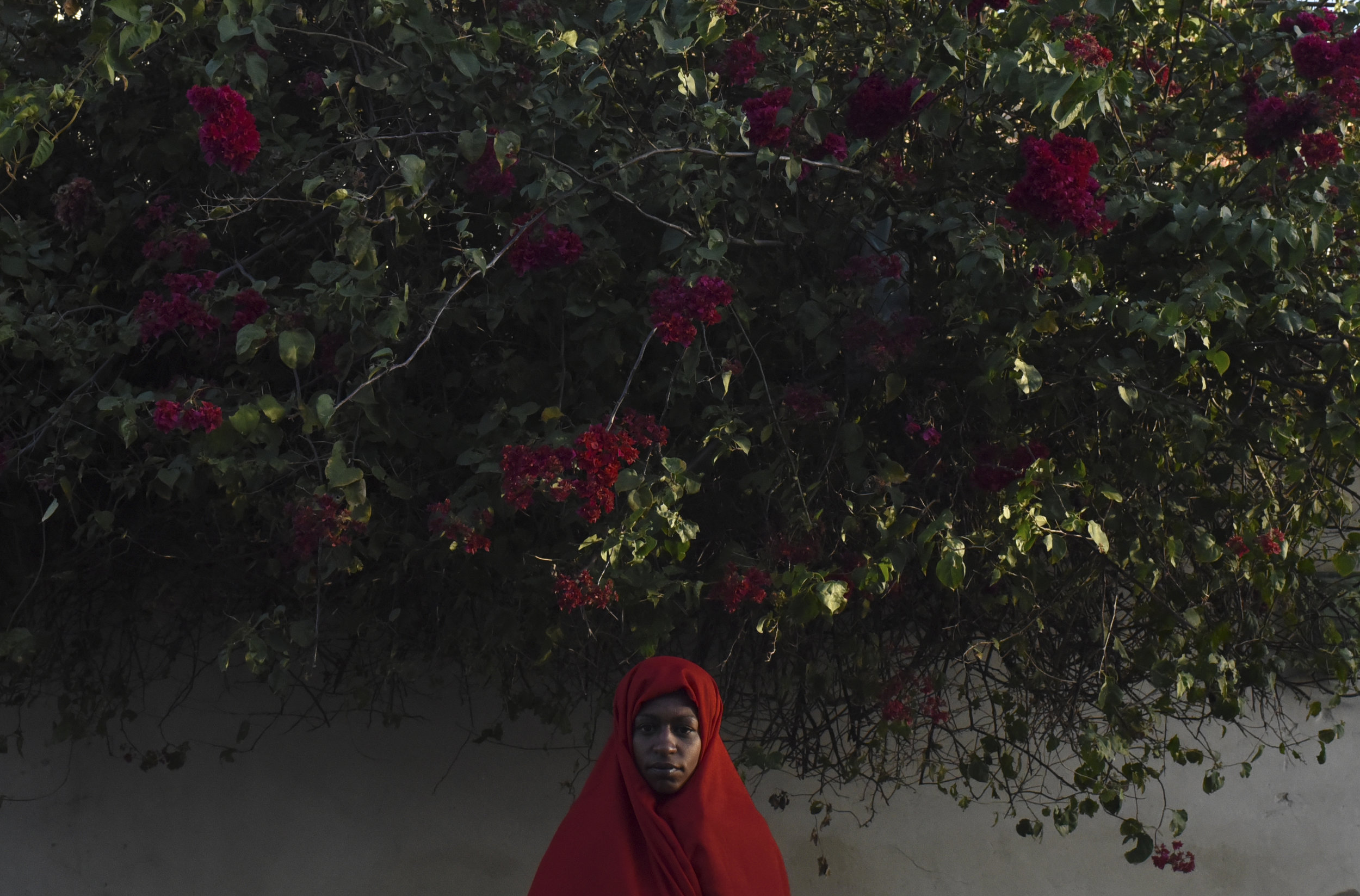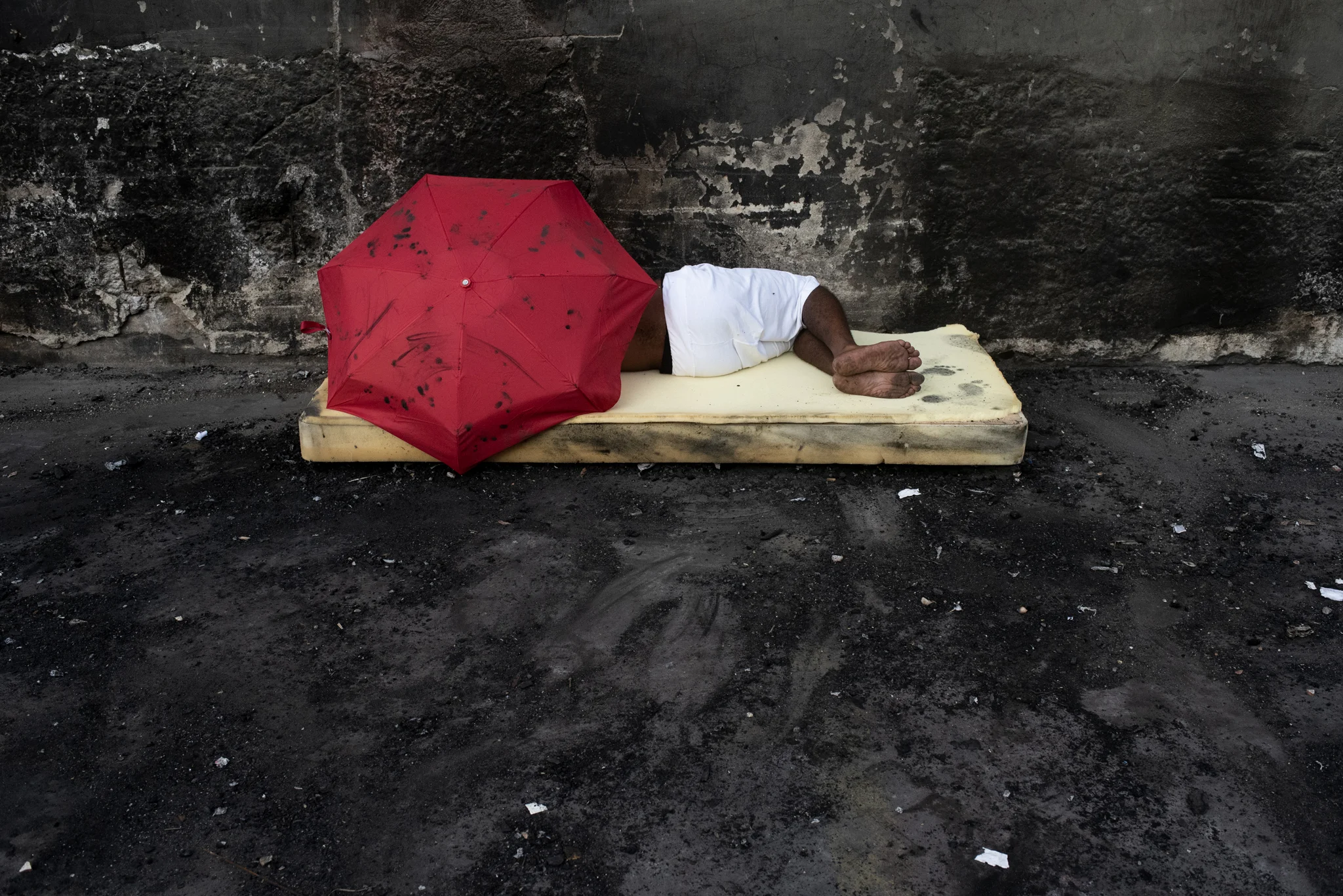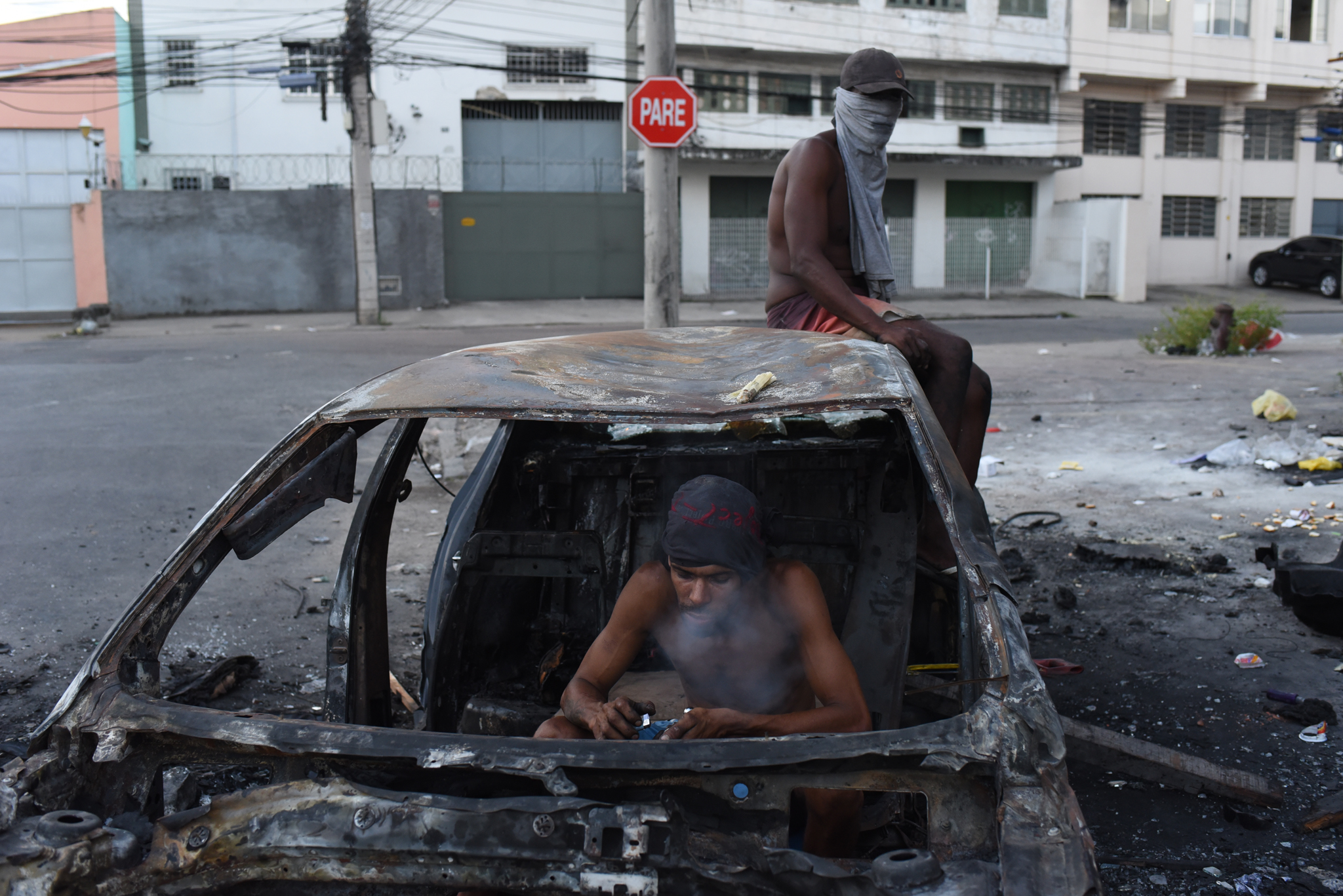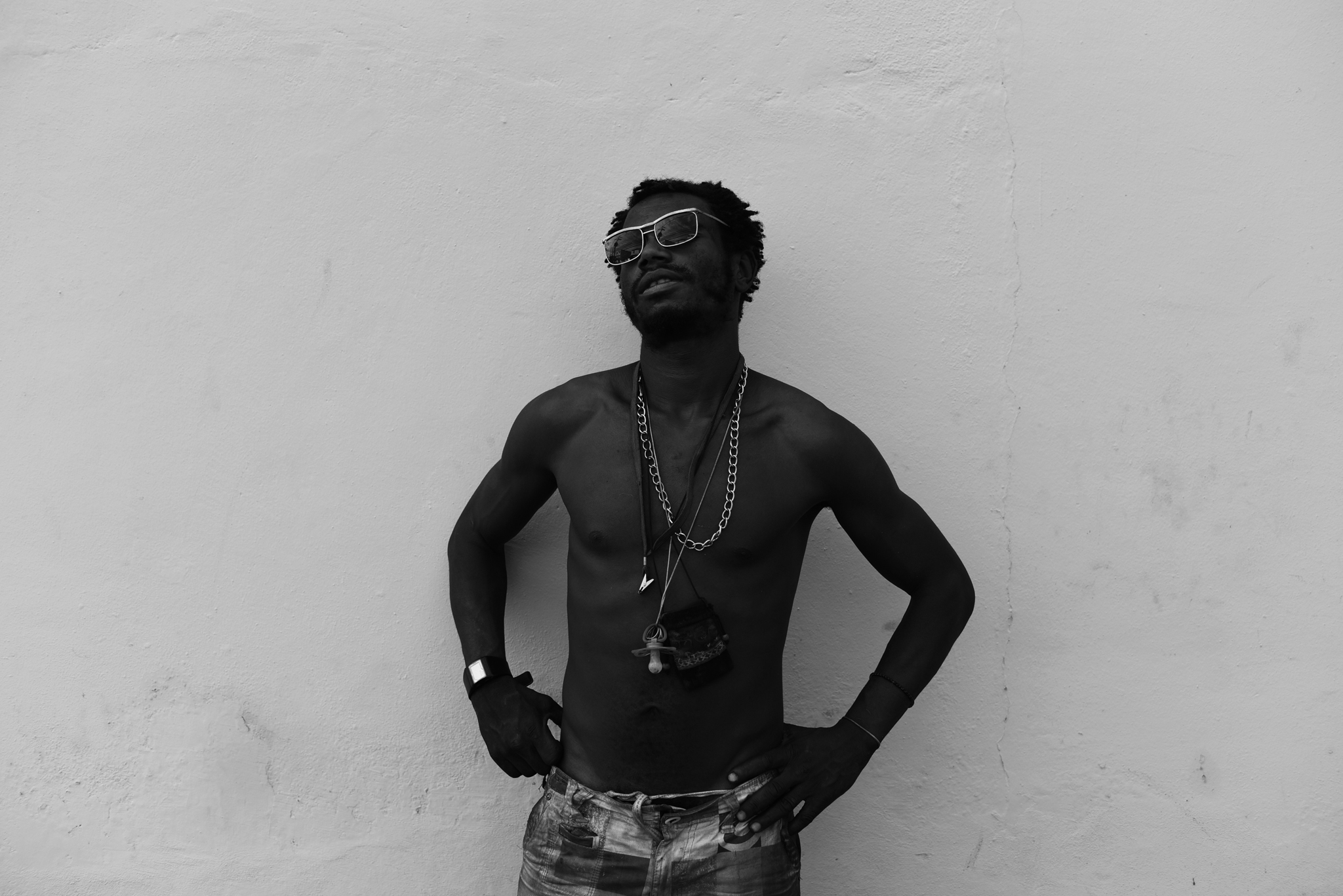Rio's Concentration Camp: the drug scene in the favela Maré
The Crackland in Rio— Portraits of people from the drug scene in the favela Maré. By the collective Plataforma 9. The ‘making-of’ of this piece can be seen here.
Photos by Fabio Teixeira
We are at the Maré complex, a grouping of favelas in the northern region of Rio de Janeiro. A place of absurdities and powers, where stories sewn together form part of the history of the city of Rio de Janeiro, Brazil, and the world. Here, it is blatant what society, in a mixture of confusion and shame, tries to hide. To simplify Maré in order to understand what life looks like here is impossible: it is complex and can bring together opposites, challenging reason. The tentacles of a corrupt system of exploitation certainly reach here.
Now we are in one of the drug use scenes of the Maré favela complex. Pejoratively called “cracolândia," the region is located on the Brasil Avenue, which crosses Brazil through its continental length, from end to end. This is where human excesses are dumped and contained. And it is also here that a concentration camp without walls is sustained through the theft of autonomy of drug users. We know who the thief is.
Cracolândia has this name because most of its residents consume crack, a drug made from two common household substances and an illicit stimulant: water, sodium bicarbonate and cocaine. Crack is cheap, volatile, and has quick effects. Consumers speak of an intense sense of power, euphoria, pleasure, and apetite loss. A crack user can lose about 10 kg in one month because it kills hunger. The addiction, they say, comes fast and is the cause of the constant violence and misery so characteristic of scenes of use, whether at Maré or Michigan. Not quite.
What separates drug use from drug addiction? For neuroscientist Carl Hart, the answer lies behind the thought provoked by this question. He is the first black professor of neuroscience at Columbia University in the United States and studies the effects of crack. Hart claims that it is not the drug chemistry that is highly addictive and causes the users' social ills. It is the exact opposite.
“I've always been a street vendor." Adriana, 30, has severe myopia but can't replace the glasses, and wants to be a dancer. “My biggest obstacle in life is the drug and the street, because the street is addictive. There are people I know who don't even use it, but they're on the street because of the street addiction."
The damaging consequences of the global capitalist system, which creates and recreates human excesses essential to its maintenance, make crack - and any other licit drug - highly attractive and addictive. The usurpation of autonomy and the creation of vulnerabilities make room for exploitation, the fundamental and indispensable basis of capitalism. What separates, therefore, drug use from drug addiction is autonomy. Illicit drugs are just the scapegoat of governments that have no interest in creating opportunities and securing access to a safe home, quality food, good education and emotional support.
“Crack is the solution to the problem of the street. And the street is the vice of the system. The ‘rock' kills the appetite, kills the cold, kills the emotions. It meets the needs," says Talita, former crack user from São Paulo (not the person pictured above).
The colloquial definition of the word “addiction" suggests moral weakness and lack of self-control. In addition, there is a distinction between addiction that leads to chemical or psychological dependence. This definition does not do justice to the reality of crack users and is not the definition devised by researchers in the field. To understand the complexity of physical addiction, it is helpful to understand the opposite of addiction: autonomy.
According to psychiatrist and academic Flávia Fernando, from the Federal Fluminense University (UFF), autonomy does not mean complete independence. After all, we live on a planet where it is inevitable to influence one another, and to depend on things and people other than ourselves. We depend on unpolluted water, on food reaching supermarkets, on the neighbour being quiet so we can sleep, in some cases on psychiatric drugs, and always on a bed and a ceiling too. It is impossible to be completely independent. Therefore, “autonomy" means being able to depend on a wide variety of things and people, rather than relying on a single thing. In other words, dependency is overcome as it becomes possible to depend on a wide range of other things.
Autonomy presupposes choice and drug users at Maré do not have them, they were robbed. Among men and women, mostly young and black, they live below a highway under construction, squeezed between two lanes of the country's largest avenue: they can't even afford the cheapest house in the favela. Without much to lose, they venture between cars to cross the avenue from one point to another. Noise, pollution and violence are as ubiquitous as air. The “drug war” comes here in the form of rifle bullets from police helicopters. “Harm reduction” comes here in the form of internment, forced labor and compulsory Christian doctrine.
If we take this perspective on autonomy and dependency into consideration when looking at crack users, we can develop a more refined understanding of the causes behind a so-called “disabling addiction." The substance itself is not what causes crime, misery, poverty and so on. If it were, the “war on drugs" would have been more effective, as it proposes to eradicate the substances through intimidation of users and traffickers. Attempting to impede the access to drugs does not solve the problem of homelessness, low self-esteem, lack of professional opportunities, no access to an enriching education and to a healthy diet. The causes behind crack addiction lie in society's failure to provide a wider range of opportunities to these people. In other words, the problem is our inability to offer options, and the chance for them to choose and rely on what is offered.
The loss of autonomy is also the loss of identity. With limited options, the opportunity to make personal choices is scarce. Individuality disintegrates, as do the fingerprints of those who use the drug severely.
The Police coerces and shoots indiscriminately, after all, they are dealing with unidentifiable bodies. This armed coercion ensures the maintenance of urban concentration camps with invisible walls, a practice that does anything but minimize violence and misery.
When we use the term “concentration camp" we deliberately allude to the fascism we have already seen manifested in Europe. Fascism proposes a political system in which eliminationist violence is allowed. The connection between a nationalistic ideology and the initiative to 'cleanse' the population is undeniable. In Brazil, we call this the extermination policy.
Here, “extermination" is used in the literal, murderous sense of the term. According to the 10 stages of the genocide briefing designed by the president of Genocide Watch, stage 8 consists of expropriation, forced displacement, ghettos and concentration camps. The Maré favela complex in Rio de Janeiro is a ghetto that shows indisputable evidence of forced displacement. Under the paternalist aid of the state, the 16 favelas in the region were built around the Brasil Avenue. The construction of this highway, executed on the site of the drug use scene this text centres on, reveals how capitalist dynamics built one of the largest favela complexes in the state of Rio de Janeiro.
In the late 1940s, the inauguration process of Av. Brasil incited a massive northeastern exodus to the southeast, from the poorest region of the country to the richest. With low wages, which did not even cover the return ticket home, the solution was the construction of precarious houses in the few dry areas of the region that at the time was still a mangrove. They are still there today.
Another part of Maré's creation story also reveals the modus operandi of the global capitalist system. In the early 1960s, the government, managing the human excess that sustain capitalism, removed residents from the favelas of Rio de Janeiro's wealthy region to the remote and impoverished Leopoldina region, the city's historic northern zone.
More recently, the public transport project that promised to connect the international airport with the rich areas of Rio de Janeiro, the TransCarioca, cut through the Maré and is indefinitely unfinished. Today, the remains of the construction shelter the “cracolândia", and the government official responsible for the failure of the project is in jail. The former secretary of construction [1], arrested last year, managed bribes and oversaw the execution of a project that held no resemblance to the project that was funded. Such misuse of funds is a crime that harms generations of people.
Daniele, 37, has a 9 year old son whom she hasn't seen in 4 years. She has used crack since she was 23 years old.
“Crack takes away the neurons, eats up everything. My dream is to get out of this life and raise my child. Something I didn't do when he was a kid, a little one. The only dream I have is to quit crack and interact with society again. Because this drug turns me into a vegetable. I don't know the price of 1 kilo of sugar. The TV programming I also can't tell you. I woke up today with a military operation in Maré and the 'withdrawal-like' desire to use crack. Lots of gun shots, real shooting. Crack users suffer from all kinds of prejudice.”
The vulnerability created by this displacement was the basis of the favela complex's construction, and its constant recreation erects the invisible walls of this concentration camp.
Based on the 10 stages devised by the Genocide Watch mentioned above, the development of this genocidal system becomes blatant. Drug users were framed as “the other"; racial and class discrimination at various levels of society impedes access to spaces and opportunities; forced geographical displacement weakens the community as a whole; the dehumanising process of loss of autonomy and identity makes self-awareness and the development of self-esteem impossible; media polarisation on crime and the “war on drugs” during elections reinforces violent public security policies; military/police interventions terrorize and kill; and finally, the extremely high mortality rate of a specific and geographically contained group of people mirrors a holocaust.
The promise of a security state, faced with the constant creation and recreation of an increasingly dangerous and non-existent threat, is successfully propagated through the invention of a collective imagination in which some are the object of empathy and others of distrust. The physical separation between these two types of people, whether walled or not, is the easiest way to put genocides into practice — objective and subjective — serving the capital. National borders, apartheids, concentration camps, mass incarcerations, ghettos, and drug use scenes are some of the updates.
Using human rights as lambskin, capitalism updates its dynamics by assembling tools of social resistance. War and genocide have been practiced globally since the sixteenth century under the excuse of order and control of the other by the norms of European universalism. In the twentieth and twenty-first centuries, paternalistic oversight of human rights-driven anti-colonial revolutions put into practice the exploitation necessary for the maintenance of capitalism. It has not yet been possible to think about human rights beyond capital. Will it be possible one day?
Edna Cristina, 43, has 9 children and has used crack for 12 years. She says having a place to live and being with her children would help her stop using it. She would like to work as a kitchen helper, has not finished her studies, and can “more or less” read and write. “I can't afford a place to live.”
The violent state methods, in wishing to annihilate the otherness that resists order, are disguised by the discourse of social welfare and human rights directed at this other. Punishment and control are needed because the other cannot determine what is best for themselves: autonomy is still being stolen. With the realisation that the state is inherently violent, the politics as a continuation of war starts to make sense. It is “perpetual peace through perpetual warfare” (from Paul Arantes's book Extinction). It is the order in hegemonic terms conquered by the militarisation of life in scenes of drug use, ghettos, slums and peripheries around the world.
The capitalist system, in addition to being structural and structuring, is constantly being updated, creating new tentacles that are able to touch — and destroy — further and deeper. There is no place, objective or subjective, that is saved. And genocide has different ways of killing. Capitalism wants not only dead bodies, but lifeless bodies as well. Subjective genocide is present in the lost eyes, the neurotic way of acting and the constant distrust.
Our society has problems for which solutions will not be profitable, only fair. Coercing, imprisoning and killing homeless drug users may be lucrative for some, but it will not solve the problem of drug abuse. The solution lies in taking responsibility as a society for systematically destroying the self-esteem of marginalised peoples and for sustaining a blatantly unequal structure of opportunities.
[1] - We chose not to name the secretary because we believe the problem is systemic, institutional, structural, structuring and not just about this individual.
PLATAFORMA 9
Photos by Fabio Teixeira.
Text by Hannah Vasconcellos and Mirna Wabi-Sabi.
Translated and edited by Mirna Wabi-Sabi.
PLATAFORMA 9 is a media collective based in the Rio de Janeiro/Maré/Niterói area.







































